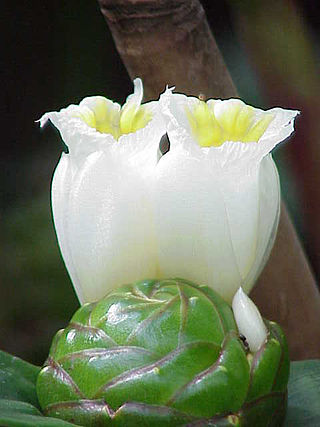
The Zingiberales are flowering plants forming one of four orders in the commelinids clade of monocots, together with its sister order, Commelinales. The order includes 68 genera and 2,600 species. Zingiberales are a unique though morphologically diverse order that has been widely recognised as such over a long period of time. They are usually large herbaceous plants with rhizomatous root systems and lacking an aerial stem except when flowering. Flowers are usually large and showy, and the stamens are often modified (staminodes) to also form colourful petal-like structures that attract pollinators.

Costaceae, known as the Costus family or spiral gingers, is a family of pantropical monocots. It belongs to the order Zingiberales, which contains horticulturally and economically important plants such as the banana (Musaceae), bird-of-paradise (Strelitziaceae), and edible ginger (Zingiberaceae). The seven genera in Costaceae together contain about 143 known species. They are native to tropical climates of Asia, Africa, Central America, and South America. Several species are frequently found in cultivation.

Watsonia is a genus of plants in the family Iridaceae, subfamily Crocoideae. Watsonias are native to southern Africa. The genus is named after Sir William Watson, an 18th-century British botanist.

Costus is a genus of herbaceous perennial plants in the family Costaceae, erected by Linnaeus in 1753. It is widespread through tropical and subtropical regions of Asia, Africa, and the Americas.
Paulus Johannes Maria "Paul" Maas is a botanist from the Netherlands and a specialist in the flora of the neotropics. Maas has identified and named about two hundred fifty plants from the Burmanniaceae, the Costus Family (Costaceae), the Gentian Family (Gentianaceae), the Bloodwort Family (Haemodoraceae), the Banana Family (Musaceae), the Olacaceae, the Triuridaceae, and the Ginger Family (Zingiberaceae).

Cheilocostus speciosus, or crêpe ginger, is a species of flowering plant in the family Costaceae. Some botanists have now revived the synonym Hellenia speciosa for this species.

Hillegonda (Hiltje) Maas-van de Kamer is a botanist at the Institute of Systematic Botany at Utrecht University. She is the wife of Professor Paul Maas and together they have published many papers. She is a specialist in the flora of the neotropics.

Hesperantha is a genus of cormous flowering plants in the family Iridaceae. The genus name is derived from the Greek words hesperos, meaning "evening", and anthos, meaning "flower".

Costus osae is a species of flowering plant in the family Costaceae. One of many rare tropical plants in the Costus family, Costus osae is a species native to Costa Rica described in 1997 . It has also been reported from Colombia.

Costus spicatus, also known as spiked spiralflag ginger or Indian head ginger, is a species of herbaceous plant in the Costaceae family.

Chamaecostus cuspidatus, common name fiery costus or spiral flag, is a species of herbaceous plant in the family Costaceae native to eastern Brazil. In India, it is known as insulin plant for its purported anti-diabetic properties. Chamaecostus cuspidatus has large fleshy-looking leaves. The undersides of these large, smooth, dark green leaves have light purple shade. The leaves are spirally arranged around the stem, forming attractive, arching clumps arising from underground rootstocks. The maximum height of these plants is about two feet. The flowers are orange in color and are 1.5 in (3.8 cm) in diameter. Flowering occurs during the warm months and they appear to be cone-like heads at the tips of branches.

Dimerocostus is a group of flowering plants in the Costaceae described as a genus in 1891. It is native to Central and South America.

Costus spectabilis, commonly known as the yellow trumpet, is an African, gregarious species of herb; low and perennial, it is found from Sierra Leone to Sudan to as far south as Angola and Zimbabwe.
Costus curvibracteatus is a tropical rhizomatous perennial native to Costa Rica and Panama.

Costus woodsonii, the red button ginger or scarlet spiral flag, is a species of flowering plant in the family Costaceae, native to Nicaragua, Costa Rica, Panama, and Colombia. A rhizomatous geophytic perennial, it is recommended for coastal gardens, borders, containers, and general wet, tropical garden applications. It is more widely cultivated than other species of Costus. Costus woodsonii is named for Robert Woodson of the Missouri Botanical Garden.

Costus pulverulentus, the red cigar or spiral ginger, is a species of flowering plant in the family Costaceae. It is native to Mexico, Central America, Colombia, Venezuela, and Ecuador, and it has been introduced to Cuba. A rhizomatous perennial reaching 4 to 6 ft, it is typically found in wet tropical areas. It is used as an ornamental, and there are cultivars, including 'Serena', 'Pink Lips', and 'Purple Passion'. In Ecuador, Costus pulverulentus is traditionally used to treat snakebite.

Costus dubius is a species of plant native to Tropical Africa.

Costus lucanusianus is a species of plant native to Africa. It is widely distributed across North East Africa, West Africa, Central Africa, East Africa, and Southern Tropical Africa.
Costus scaber is a species of plant in the Costaceae family. Its native range is Mexico to Tropical America.

Costus productus, known as Orange Tulip Ginger, Dwarf Orange Ginger, or Green Mountain Spiral Flag, is a species of plant in the Costaceae family. Costus productus is native to South Colombia and Peru.
















